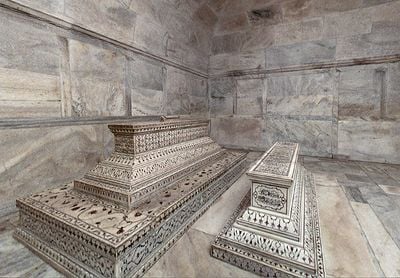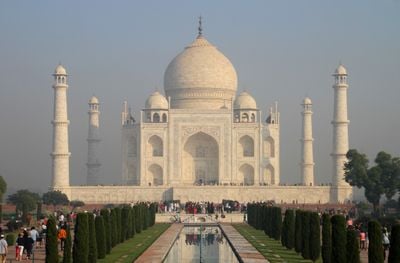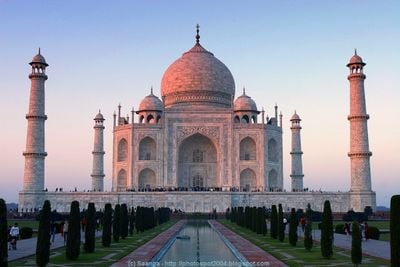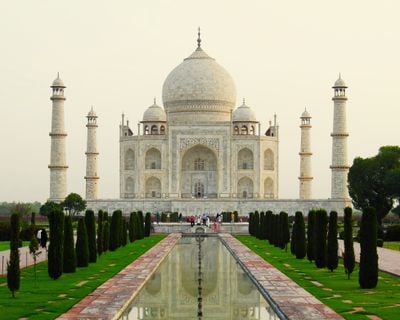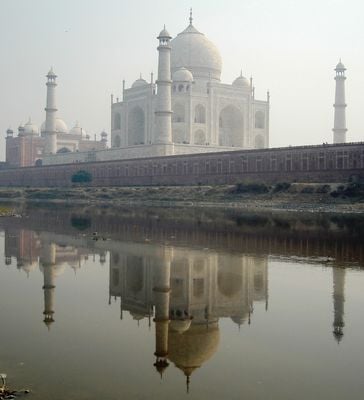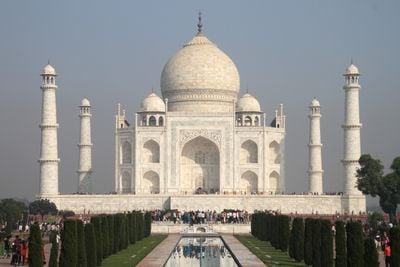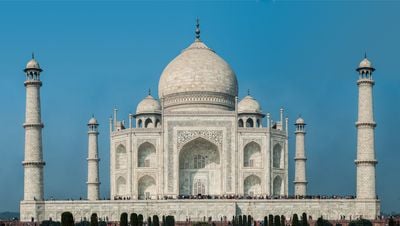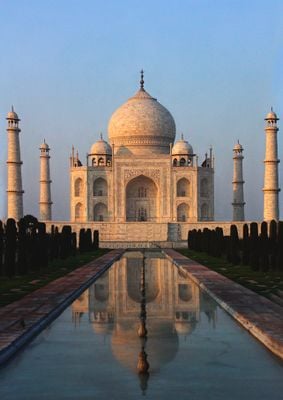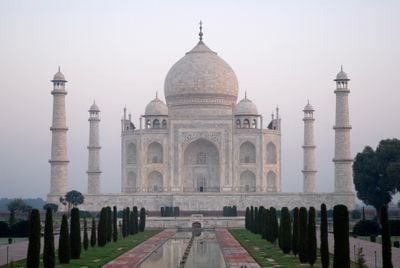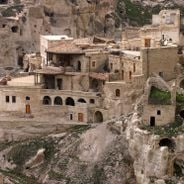
Taj Mahal, Marble mausoleum in Agra, India.
The white marble structure rises 239 feet (73 meters) high on a raised platform along the Yamuna River bank. Four slender minarets each reaching 131 feet (40 meters) frame the corners of the platform. The central dome rises above an octagonal drum, flanked by smaller cupolas. Reflecting pools stretch through formal gardens before the main entrance to the burial chamber.
Shah Jahan commissioned construction in 1632 for his wife Mumtaz Mahal, who died during the birth of their fourteenth child. More than twenty thousand craftsmen from Persia, the Ottoman Empire, and Europe worked on the project for two decades until completion. The emperor was later interred beside his wife after his son Aurangzeb deposed him in 1658. British colonial authorities initiated first restoration efforts during the 19th century to preserve the deteriorating structure.
As a symbol of eternal love, the structure draws artists, writers, and visitors from around the world. Calligraphic inscriptions from the Quran adorn entrances and walls, while the symmetrical garden layout following Persian tradition represents earthly paradise. The synthesis of Islamic, Persian, and Indian building traditions reflects the cosmopolitan character of the Mughal empire during its height.
Visitors should arrive early in the morning to avoid large crowds and obtain better photographs, as the complex opens at sunrise. The compound remains closed on Fridays. Tickets can be purchased online to reduce waiting times at entrance gates. The main entrance is located on the south side of the complex. Photography is permitted throughout the grounds, but tripods require special permissions. Inside the burial chamber, photography is prohibited entirely.
The marble walls contain thousands of inlaid semi-precious stones forming floral patterns with special light transmission properties that change hue depending on time of day. Lapis lazuli, jade, crystal, turquoise, and carnelian were used for this inlay work called pietra dura. Under moonlight, the facade appears in silvery white, while at dusk it glimmers pink and golden. The optical effects result from varying density and light refraction of the materials used in construction.
Location: Agra
Location: Uttar Pradesh
Inception: 1631
Founders: Shah Jahan
Architects: Ahmad Lahori
Architectural style: Islamic architecture, architecture of Iran, Mughal architecture
Height: 73 m
Accessibility: Wheelchair accessible
Made from material: marble
Address: Dharmapuri, Forest Colony, Tajganj, Agra, Uttar Pradesh 282001, India 282001 Agra
Phone: +915622226431
Website: https://tajmahal.gov.in
GPS coordinates: 27.17500,78.04194
Latest update: November 27, 2025 20:20

This collection presents significant architectural works from different periods and continents. From medieval cathedrals to contemporary skyscrapers, the selection documents the technical and aesthetic development of building design. The listed buildings were created by influential architects and have shaped the evolution of modern architecture. The list includes religious structures such as Gothic churches and monasteries, public facilities like museums and concert halls, and residential buildings that established new construction standards. Each building demonstrates particular structural solutions or stylistic features that contribute to understanding architectural history. The selection offers insights into various building styles, materials and construction methods.

This collection brings together notable domes and cupolas from all continents, signs of diverse architectural traditions extending from the Vatican to Australia, Russia to the United Arab Emirates. From the famous dome of St. Peter's Basilica in Rome to the colorful domes of the Church of the Savior on Spilled Blood in Saint Petersburg, the Renaissance dome of Florence Cathedral, to the cast-iron dome of the US Capitol in Washington, each structure tells a particular story and reflects the ambitions of its era. These buildings span several centuries of architectural innovation and serve various functions: religious structures like the Sheikh Zayed Grand Mosque or the Basilica of Our Lady of Peace in Côte d'Ivoire, civil buildings such as Oxford's Radcliffe Camera or the Australian Exhibition Palace, and even thermal spas like Budapest’s Széchenyi Baths. Each dome illustrates construction techniques and aesthetic decisions specific to its culture, offering insight into skills that enabled the creation of these monumental coverings.

These archaeological sites document the development of human civilizations across thousands of years. They range from the earliest known temple structures like Göbekli Tepe in Turkey, dated to around 9500 BCE, to the preserved remains of Pompeii, frozen in time by a volcanic eruption in 79 CE. Each location offers insights into the technical abilities, religious beliefs, and social structures of past cultures.

This collection encompasses ancient stone monuments and sacred sites from across the globe, ranging from the Easter Island Moai to the Great Wall of China. The structures represent millennia of human engineering and include religious temples, fortifications, burial sites, and astronomical installations. Many of these locations retain cultural significance for local communities today. Examples include prehistoric sites such as Göbekli Tepe in Turkey and Skara Brae in the Orkney Islands, alongside monumental constructions like the Parthenon in Athens, Angkor Wat in Cambodia, and the Pyramids of Giza in Egypt. The collection also features lesser known treasures including the Megalithic Temples of Malta, Nan Madol in Micronesia, and Great Zimbabwe. These sites provide insight into ancient cultures, religious practices, and architectural achievements that continue to draw visitors from around the world.

In 2007, the New Seven Wonders Foundation, led by Swiss businessman Bernard Weber in cooperation with the marketing company Deureka, organized a global vote, the results of which were announced on July 7 in Lisbon. This project, which was especially successful in India and China, enabled the designation of seven monuments representing different civilizations and eras, from antiquity to the 20th century. UNESCO stated in a release that it was not involved in this event, contrary to what many voters believed. The final selection includes sites across all continents: the Great Wall of China, a fortification system built over several centuries; Petra in Jordan, a Nabataean city from the 4th century BC carved into rose-colored rock; the Colosseum in Rome, a 1st-century amphitheater capable of holding 50,000 spectators; Chichen Itza in Mexico, a Maya site demonstrating the astronomical knowledge of this civilization; Machu Picchu in Peru, an Inca city from the 15th century located at 2,430 meters above sea level; the Taj Mahal in India, a white marble mausoleum built between 1631 and 1643; and the Christ Rédempteur statue in Rio de Janeiro, a 38-meter-tall monument inaugurated in 1931. The Khufu pyramid, the only remaining ancient wonder still standing, was removed from the voting list and designated an honorary wonder. The 21 candidate sites were selected by a commission of architects from five continents, chaired by Federico Mayor, former UNESCO Director-General. The criteria included aesthetics, architectural achievement, and historical significance. Each monument had to be constructed by humans, completed before 2000, and in acceptable preservation condition. This collection lists all monuments and allows users to view their locations and photos via individual records.

Mehtab Bagh
526 m
Musamman Burj
1.9 km
Humanyun Mosque
872 m
Taj Mahal view point within nature walk
608 m
Taj Mahal Museum
245 m
Taj Nature Walk ₹100
840 m
Darwaza-i-Rauza
390 m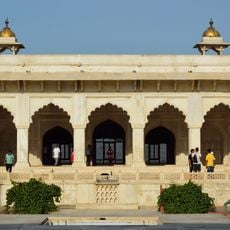
Khas Mahal
1.9 km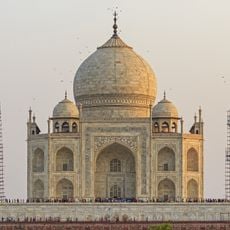
Scenic viewpoint
368 m
Tower with viewpoint on the Taj Mahal
491 m
Viewpoint of Taj Mahal & Agra Fort
1.8 km
Agra Golf Course
1.2 km
Khas Mahal
1.9 km
Musammun Burj
1.9 km
M
1.2 km
No View of Taj Mahal
437 m
View Point Taj Mahl 50 INR
414 m
Akhbari Mahal
1.9 km
Taj Mahal Mughal Garden
286 m
Sawad
1.5 km
Free view point
1.1 km
Scenic viewpoint
314 m
Scenic viewpoint
520 m
Monument
994 m
Monument
1.4 km
Monument
1.6 km
Roshnara
1.9 km
City gate
837 mReviews
Visited this place? Tap the stars to rate it and share your experience / photos with the community! Try now! You can cancel it anytime.
Discover hidden gems everywhere you go!
From secret cafés to breathtaking viewpoints, skip the crowded tourist spots and find places that match your style. Our app makes it easy with voice search, smart filtering, route optimization, and insider tips from travelers worldwide. Download now for the complete mobile experience.

A unique approach to discovering new places❞
— Le Figaro
All the places worth exploring❞
— France Info
A tailor-made excursion in just a few clicks❞
— 20 Minutes



